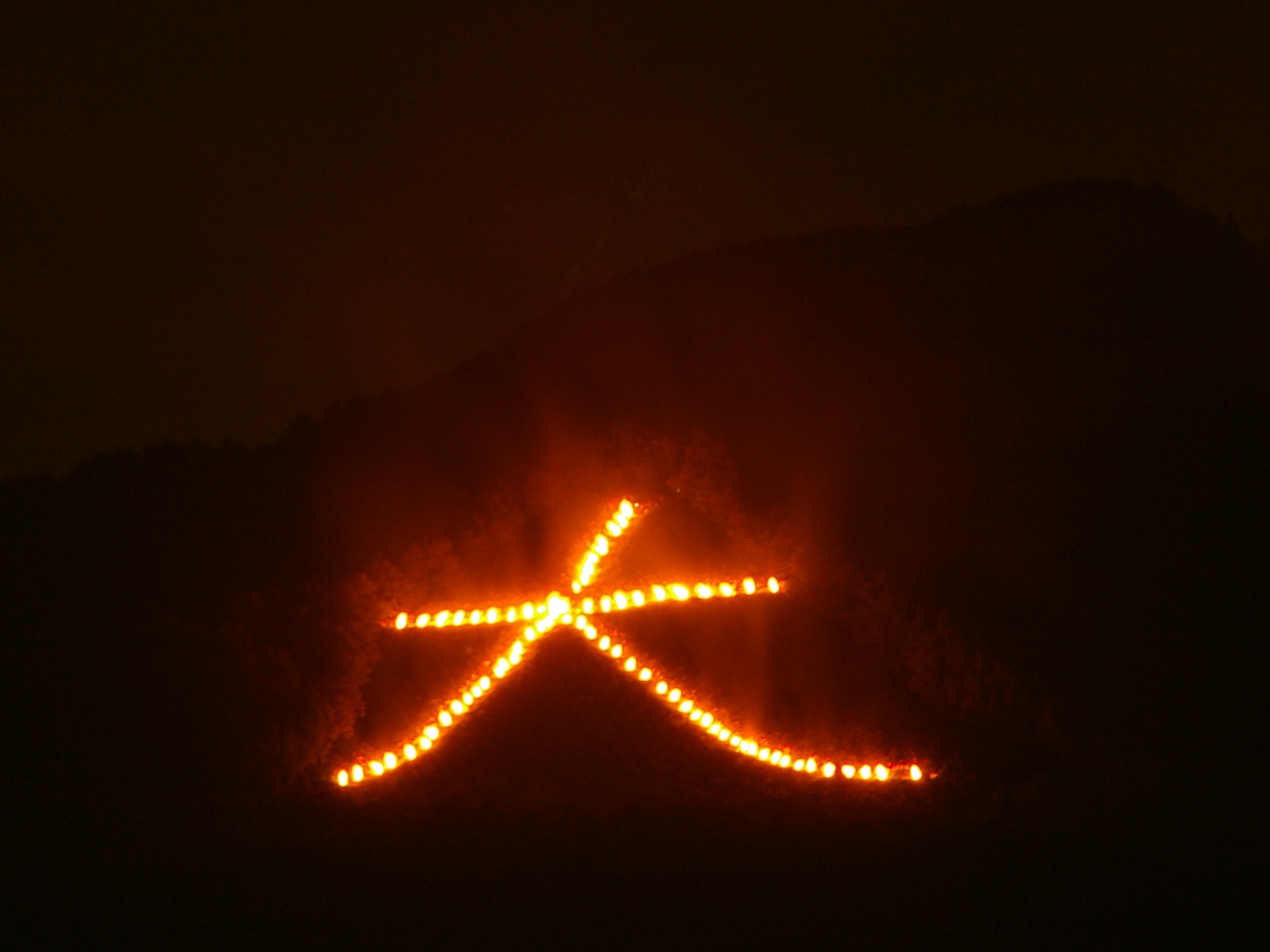Daimonji(band) on:
[Wikipedia]
[Google]
[Amazon]

 , more commonly known as , is a festival in
, more commonly known as , is a festival in
Website about with further descriptions of the bonfires
Description of in a Kyoto city tourist guide
Website about with further descriptions of the bonfires (in English)
{{DEFAULTSORT:Gozan No Okuribi August observances Religion in Kyoto Tourist attractions in Kyoto Festivals in Kyoto Hill figures Geoglyphs Buddhist festivals in Japan Bonfires Japanese words and phrases

 , more commonly known as , is a festival in
, more commonly known as , is a festival in Kyoto
Kyoto ( or ; Japanese language, Japanese: , ''Kyōto'' ), officially , is the capital city of Kyoto Prefecture in the Kansai region of Japan's largest and most populous island of Honshu. , the city had a population of 1.46 million, making it t ...
, Japan
Japan is an island country in East Asia. Located in the Pacific Ocean off the northeast coast of the Asia, Asian mainland, it is bordered on the west by the Sea of Japan and extends from the Sea of Okhotsk in the north to the East China Sea ...
. It is the culmination of the Obon
or just is a fusion of the ancient Japanese belief in ancestral spirits and a Japanese Buddhist custom to honor the spirits of one's ancestors. This Buddhist custom has evolved into a family reunion holiday during which people return to ance ...
festival on August 16, in which five giant bonfire
A bonfire is a large and controlled outdoor fire, used for waste disposal or as part of a religious feast, such as Saint John's Eve.
Etymology
The earliest attestations date to the late 15th century, with the Catholicon Anglicum spelling i ...
s are lit on mountains surrounding the city. It signifies the moment when the spirits of deceased family members, who are said to visit this world during Obon, are believed to be returning to the spirit world—thus the name .
History
The origins of the festival are obscure, but it is believed to be ancient. Specific families have the hereditary duty of organizing all the logistics of the bonfires, and they spend many hours annually providing volunteer labor to maintain this tradition.Schedule
Starting at 8 pm, the giant bonfires are lit, each with a distinctive shape. Three of the fires form giantkanji
are logographic Chinese characters, adapted from Chinese family of scripts, Chinese script, used in the writing of Japanese language, Japanese. They were made a major part of the Japanese writing system during the time of Old Japanese and are ...
characters, and two form familiar shapes. The characters, their locations, meanings, and the lighting times are:
*, the character meaning "large" or "great", is lit on Daimonji-Yama/Higashi-Yama, Nyoigatake at 8 pm;
*, the characters meaning "wondrous dharma
Dharma (; , ) is a key concept in various Indian religions. The term ''dharma'' does not have a single, clear Untranslatability, translation and conveys a multifaceted idea. Etymologically, it comes from the Sanskrit ''dhr-'', meaning ''to hold ...
" (referring to Buddhist teachings), are lit on Matsugasaki, Nishi-Yama/Higashi-Yama at 8:10 pm;
*, the shape of a boat, is lit on Nishigamo, Funa-Yama at 8:15 pm;
*, again, the character meaning "large", is lit on Daihoku-San, Hidaridaimonji-San at 8:15 pm;
*, the shape of a shrine gate, is lit on Toriimoto, Mandara-San at 8:20 pm.
The most famous—and the first to be lit—is the character , on Kyoto's . The other four fires are lit at five to ten-minute intervals, and by 8:30, all the characters can be seen. Each bonfire lasts for 30 minutes.
The 2020 event was significantly scaled back, due to COVID-19, with only six points of lit and one point lit at each of the other four locations.
Viewing spots
The best place to view the festival is from the Nakagyō Ward, in the center of the city. Many hotels have specials where, for a fee, one can see all five fires. Many people also like to go to theKamo River
The is located in Kyoto Prefecture, Japan. The riverbanks are popular walking spots for residents and tourists. In summer, restaurants open balconies looking out to the river. There are walkways running alongside the river, and some stepping s ...
, between Sanjo and Imadegawa Streets, for an excellent view of the initial fires. More specifically, the following spots are mentioned as good viewing spots:
Latitude and longitude
*Daimonji: *Myō: *Hō: *Funagata: *Hidari Daimonji: *Toriigata:References
External links
Website about with further descriptions of the bonfires
Description of in a Kyoto city tourist guide
Website about with further descriptions of the bonfires (in English)
{{DEFAULTSORT:Gozan No Okuribi August observances Religion in Kyoto Tourist attractions in Kyoto Festivals in Kyoto Hill figures Geoglyphs Buddhist festivals in Japan Bonfires Japanese words and phrases